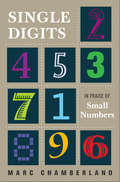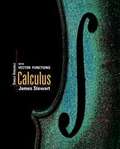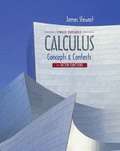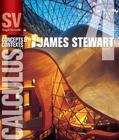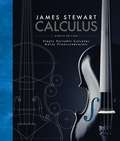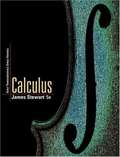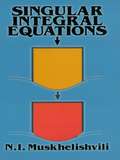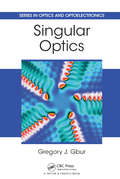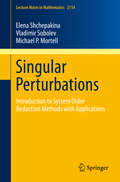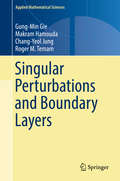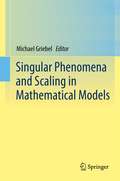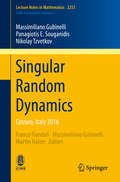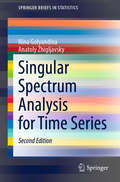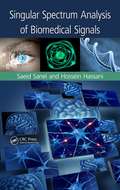- Table View
- List View
Single Cell Sequencing and Systems Immunology
by Xiangdong WangThe volume focuses on the genomics, proteomics, metabolomics, and bioinformatics of a single cell, especially lymphocytes and on understanding the molecular mechanisms of systems immunology. Based on the author's personal experience, it provides revealing insights into the potential applications, significance, workflow, comparison, future perspectives and challenges of single-cell sequencing for identifying and developing disease-specific biomarkers in order to understand the biological function, activation and dysfunction of single cells and lymphocytes and to explore their functional roles and responses to therapies. It also provides detailed information on individual subgroups of lymphocytes, including cell characters, function, surface markers, receptor function, intracellular signals and pathways, production of inflammatory mediators, nuclear receptors and factors, omics, sequencing, disease-specific biomarkers, bioinformatics, networks and dynamic networks, their role in disease and future prospects. Dr. Xiangdong Wang is a Professor of Medicine, Director of Shanghai Institute of Clinical Bioinformatics, Director of Fudan University Center for Clinical Bioinformatics, Director of the Biomedical Research Center of Zhongshan Hospital, Deputy Director of Shanghai Respiratory Research Institute, Shanghai, China.
Single Digits
by Marc ChamberlandThe numbers one through nine have remarkable mathematical properties and characteristics. For instance, why do eight perfect card shuffles leave a standard deck of cards unchanged? Are there really "six degrees of separation" between all pairs of people? And how can any map need only four colors to ensure that no regions of the same color touch? In Single Digits, Marc Chamberland takes readers on a fascinating exploration of small numbers, from one to nine, looking at their history, applications, and connections to various areas of mathematics, including number theory, geometry, chaos theory, numerical analysis, and mathematical physics.Each chapter focuses on a single digit, beginning with easy concepts that become more advanced as the chapter progresses. Chamberland covers vast numerical territory, such as illustrating the ways that the number three connects to chaos theory, an unsolved problem involving Egyptian fractions, the number of guards needed to protect an art gallery, and problematic election results. He considers the role of the number seven in matrix multiplication, the Transylvania lottery, synchronizing signals, and hearing the shape of a drum. Throughout, he introduces readers to an array of puzzles, such as perfect squares, the four hats problem, Strassen multiplication, Catalan's conjecture, and so much more. The book's short sections can be read independently and digested in bite-sized chunks--especially good for learning about the Ham Sandwich Theorem and the Pizza Theorem. Appealing to high school and college students, professional mathematicians, and those mesmerized by patterns, this book shows that single digits offer a plethora of possibilities that readers can count on.
Single Subject Designs in Biomedicine
by Janine E. Janosky Michael P. Hoerger Shelley L. Leininger Terry M. LibkumanSingle Subject Designs in Biomedicine draws upon the rich history of single case research within the educational and behavioral research settings and extends the application to the field of biomedicine. Biomedical illustrations are used to demonstrate the processes of designing, implementing, and evaluating a single subject design. Strengths and limitations of various methodologies are presented, along with specific clinical areas of application in which these applications would be appropriate. Statistical and visual techniques for data analysis are also discussed. The breadth and depth of information provided is suitable for medical students in research oriented courses, primary care practitioners and medical specialists seeking to apply methods of evidence practice to improve patient care, and medical researchers who are expanding their methodological expertise to include single subject designs. Increasing awareness of the utility in the single subject design could enhance treatment approach and evaluation both in biomedical research and medical care settings.
Single Variable Calculus with Vector Functions
by James StewartStewart's SINGLE VARIABLE CALCULUS WITH VECTOR FUNCTIONS has the mathematical precision, accuracy, clarity of exposition and outstanding examples and problem sets that characterized all of James Stewart's texts. In this new text, Stewart focuses on problem solving, using the pedagogical system that has worked so well for students in a wide variety of academic settings throughout the world.
Single Variable Calculus with Vector Functions (for AP Calculus)
by James StewartStewart's SINGLE VARIABLE CALCULUS WITH VECTOR FUNCTIONS has the mathematical precision, accuracy, clarity of exposition and outstanding examples and problem sets that characterized all of James Stewart's texts. In this new text, Stewart focuses on problem solving, using the pedagogical system that has worked so well for students in a wide variety of academic settings throughout the world.
Single Variable Calculus with Vector Functions, Concepts and Contexts
by James StewartThis textbook offers a streamlined approach to teaching calculus, focusing on major concepts and supporting those with precise definitions, patient explanations, and carefully graded problems.
Single Variable Calculus with Vector Functions: Concepts And Contexts (for Ap Calculus)
by James StewartNIMAC-sourced textbook
Single Variable Calculus: Concepts and Contexts
by James StewartStewart's CALCULUS: CONCEPTS AND CONTEXTS, FOURTH EDITION offers a streamlined approach to teaching calculus, focusing on major concepts and supporting those with precise definitions, patient explanations, and carefully graded problems. CALCULUS: CONCEPTS AND CONTEXTS is highly regarded because this text offers a balance of theory and conceptual work to satisfy more progressive programs as well as those who are more comfortable teaching in a more traditional fashion. Each title is just one component in a comprehensive calculus course program that carefully integrates and coordinates print, media, and technology products for successful teaching and learning.
Single Variable Calculus: Concepts and Contexts
by James StewartStewart's CALCULUS: CONCEPTS AND CONTEXTS, FOURTH EDITION offers a streamlined approach to teaching calculus, focusing on major concepts and supporting those with precise definitions, patient explanations, and carefully graded problems. CALCULUS: CONCEPTS AND CONTEXTS is highly regarded because this text offers a balance of theory and conceptual work to satisfy more progressive programs as well as those who are more comfortable teaching in a more traditional fashion. Each title is just one component in a comprehensive calculus course program that carefully integrates and coordinates print, media, and technology products for successful teaching and learning.
Single Variable Calculus: Early Transcendentals
by James StewartSuccess in your calculus course starts here! James Stewart's CALCULUS texts are world-wide best-sellers for a reason: they are clear, accurate, and filled with relevant, real-world examples. With CALCULUS: EARLY TRANCENDENTALS, Sixth Edition, Stewart conveys not only the utility of calculus to help you develop technical competence, but also gives you an appreciation for the intrinsic beauty of the subject. His patient examples and built-in learning aids will help you build your mathematical confidence and achieve your goals in the course!
Single Variable Calculus: Early Transcendentals (5th edition)
by James StewartStewart (McMaster U., Canada) includes new exercises and emphasis on verbal instruction in this edition of his undergraduate text on single variable calculus. Also new to this edition are four diagnostic tests in prerequisite subjects. The 11 chapters cover functions and models, limits and derivatives, differentiation rules, applications of differentiation, integrals, applications and techniques of integration, differential equations, parametric equations and polar coordinates, and infinite sequences and series. Exercises requiring a graphing calculator or computer algebra system are marked as such.
Single-Arm Phase II Survival Trial Design (Chapman & Hall/CRC Biostatistics Series)
by Jianrong WuSingle-Arm Phase II Survival Trial Design provides a comprehensive summary to the most commonly- used methods for single-arm phase II trial design with time-to-event endpoints. Single-arm phase II trials are a key component for successfully developing advanced cancer drugs and treatments, particular for target therapy and immunotherapy in which time-to-event endpoints are often the primary endpoints. Most test statistics for single-arm phase II trial design with time-to-event endpoints are not available in commercial software. Key Features: Covers the most frequently used methods for single-arm phase II trial design with time-to-event endpoints in a comprehensive fashion. Provides new material on phase II immunotherapy trial design and phase II trial design with TTP ratio endpoint. Illustrates trial designs by real clinical trial examples Includes R code for all methods proposed in the book, enabling straightforward sample size calculation.
Singular Algebraic Curves: With an Appendix by Oleg Viro (Springer Monographs in Mathematics)
by Gert-Martin Greuel Christoph Lossen Eugenii ShustinSingular algebraic curves have been in the focus of study in algebraic geometry from the very beginning, and till now remain a subject of an active research related to many modern developments in algebraic geometry, symplectic geometry, and tropical geometry. The monograph suggests a unified approach to the geometry of singular algebraic curves on algebraic surfaces and their families, which applies to arbitrary singularities, allows one to treat all main questions concerning the geometry of equisingular families of curves, and, finally, leads to results which can be viewed as the best possible in a reasonable sense. Various methods of the cohomology vanishing theory as well as the patchworking construction with its modifications will be of a special interest for experts in algebraic geometry and singularity theory. The introductory chapters on zero-dimensional schemes and global deformation theory can well serve as a material for special courses and seminars for graduate and post-graduate students.Geometry in general plays a leading role in modern mathematics, and algebraic geometry is the most advanced area of research in geometry. In turn, algebraic curves for more than one century have been the central subject of algebraic geometry both in fundamental theoretic questions and in applications to other fields of mathematics and mathematical physics. Particularly, the local and global study of singular algebraic curves involves a variety of methods and deep ideas from geometry, analysis, algebra, combinatorics and suggests a number of hard classical and newly appeared problems which inspire further development in this research area.
Singular Differential Equations and Special Functions (Mathematics and Physics for Science and Technology)
by Luis Manuel Braga da Costa CamposSingular Differential Equations and Special Functions is the fifth book within Ordinary Differential Equations with Applications to Trajectories and Vibrations, Six-volume Set. As a set they are the fourth volume in the series Mathematics and Physics Applied to Science and Technology. This fifth book consists of one chapter (chapter 9 of the set). The chapter starts with general classes of differential equations and simultaneous systems for which the properties of the solutions can be established 'a priori', such as existence and unicity of solution, robustness and uniformity with regard to changes in boundary conditions and parameters, and stability and asymptotic behavior. The book proceeds to consider the most important class of linear differential equations with variable coefficients, that can be analytic functions or have regular or irregular singularities. The solution of singular differential equations by means of (i) power series; (ii) parametric integral transforms; and (iii) continued fractions lead to more than 20 special functions; among these is given greater attention to generalized circular, hyperbolic, Airy, Bessel and hypergeometric differential equations, and the special functions that specify their solutions. Includes existence, unicity, robustness, uniformity, and other theorems for non-linear differential equations Discusses properties of dynamical systems derived from the differential equations describing them, using methods such as Liapunov functions Includes linear differential equations with periodic coefficients, including Floquet theory, Hill infinite determinants and multiple parametric resonance Details theory of the generalized Bessel differential equation, and of the generalized, Gaussian, confluent and extended hypergeometric functions and relations with other 20 special functions Examines Linear Differential Equations with analytic coefficients or regular or irregular singularities, and solutions via power series, parametric integral transforms, and continued fractions
Singular Integral Equations: Boundary Problems of Function Theory and Their Application to Mathematical Physics
by N. I. MuskhelishviliSingular integral equations play important roles in physics and theoretical mechanics, particularly in the areas of elasticity, aerodynamics, and unsteady aerofoil theory. They are highly effective in solving boundary problems occurring in the theory of functions of a complex variable, potential theory, the theory of elasticity, and the theory of fluid mechanics.This high-level treatment by a noted mathematician considers one-dimensional singular integral equations involving Cauchy principal values. Its coverage includes such topics as the Hölder condition, Hilbert and Riemann-Hilbert problems, the Dirichlet problem, inversion formulas for arcs, and many other areas. Intended for graduate students, applied and pure mathematicians, engineers, physicists, and researchers in a variety of scientific and industrial fields, this text is accessible to students acquainted with the basic theory of functions of a complex variable and the theory of Fredholm integral equations.
Singular Limits in Thermodynamics of Viscous Fluids
by Eduard Feireisl Antonín NovotnýMany interesting problems in mathematical fluid dynamics involve the behavior of solutions of nonlinear systems of partial differential equations as certain parameters vanish or become infinite. Frequently the limiting solution, provided the limit exists, satisfies a qualitatively different system of differential equations. This book is designed as an introduction to the problems involving singular limits based on the concept of weak or variational solutions. The primitive system consists of a complete system of partial differential equations describing the time evolution of the three basic state variables: the density, the velocity, and the absolute temperature associated to a fluid, which is supposed to be compressible, viscous, and heat conducting. It can be represented by the Navier-Stokes-Fourier-system that combines Newton's rheological law for the viscous stress and Fourier's law of heat conduction for the internal energy flux. As a summary, this book studies singular limits of weak solutions to the system governing the flow of thermally conducting compressible viscous fluids.
Singular Optics (Series in Optics and Optoelectronics)
by Gregory J. Gbur"This engagingly written text provides a useful pedagogical introduction to an extensive class of geometrical phenomena in the optics of polarization and phase, including simple explanations of much of the underlying mathematics." —Michael Berry, University of Bristol, UK "The author covers a vast number of topics in great detail, with a unifying mathematical treatment. It will be a useful reference for both beginners and experts…." —Enrique Galvez, Charles A. Dana Professor of Physics and Astronomy, Colgate University "a firm and comprehensive grounding both for those looking to acquaint themselves with the field and those of us that need reminding of the things we thought we knew, but hitherto did not understand: an essential point of reference." —Miles Padgett, Kelvin Chair of Natural Philosophy and Vice Principal (Research), University of Glasgow This book focuses on the various forms of wavefield singularities, including optical vortices and polarization singularities, as well as orbital angular momentum and associated applications. It highlights how an understanding of singular optics provides a completely different way to look at light. Whereas traditional optics focuses on the shape and structure of the non-zero portions of the wavefield, singular optics describes a wave’s properties from its null regions. The contents cover the three main areas of the field: the study of generic features of wavefields, determination of unusual properties of vortices and wavefields that contain singularities, and practical applications of vortices and other singularities.
Singular Perturbations
by Elena Shchepakina Vladimir Sobolev Michael P. MortellThese lecture notes provide a fresh approach to investigating singularly perturbed systems using asymptotic and geometrical techniques. It gives many examples and step-by-step techniques, which will help beginners move to a more advanced level. Singularly perturbed systems appear naturally in the modelling of many processes that are characterized by slow and fast motions simultaneously, for example, in fluid dynamics and nonlinear mechanics. This book's approach consists in separating out the slow motions of the system under investigation. The result is a reduced differential system of lesser order. However, it inherits the essential elements of the qualitative behaviour of the original system. Singular Perturbations differs from other literature on the subject due to its methods and wide range of applications. It is a valuable reference for specialists in the areas of applied mathematics, engineering, physics, biology, as well as advanced undergraduates for the earlier parts of the book, and graduate students for the later chapters.
Singular Perturbations and Boundary Layers (Applied Mathematical Sciences #200)
by Gung-Min Gie Makram Hamouda Chang-Yeol Jung Roger M. TemamSingular perturbations occur when a small coefficient affects the highest order derivatives in a system of partial differential equations. From the physical point of view singular perturbations generate in the system under consideration thin layers located often but not always at the boundary of the domains that are called boundary layers or internal layers if the layer is located inside the domain. Important physical phenomena occur in boundary layers. The most common boundary layers appear in fluid mechanics, e.g., the flow of air around an airfoil or a whole airplane, or the flow of air around a car. Also in many instances in geophysical fluid mechanics, like the interface of air and earth, or air and ocean. This self-contained monograph is devoted to the study of certain classes of singular perturbation problems mostly related to thermic, fluid mechanics and optics and where mostly elliptic or parabolic equations in a bounded domain are considered. This book is a fairly unique resource regarding the rigorous mathematical treatment of boundary layer problems. The explicit methodology developed in this book extends in many different directions the concept of correctors initially introduced by J. L. Lions, and in particular the lower- and higher-order error estimates of asymptotic expansions are obtained in the setting of functional analysis. The review of differential geometry and treatment of boundary layers in a curved domain is an additional strength of this book. In the context of fluid mechanics, the outstanding open problem of the vanishing viscosity limit of the Navier-Stokes equations is investigated in this book and solved for a number of particular, but physically relevant cases.This book will serve as a unique resource for those studying singular perturbations and boundary layer problems at the advanced graduate level in mathematics or applied mathematics and may be useful for practitioners in other related fields in science and engineering such as aerodynamics, fluid mechanics, geophysical fluid mechanics, acoustics and optics.
Singular Phenomena and Scaling in Mathematical Models
by Michael GriebelThe book integrates theoretical analysis, numerical simulation and modeling approaches for the treatment of singular phenomena. The projects covered focus on actual applied problems, and develop qualitatively new and mathematically challenging methods for various problems from the natural sciences. Ranging from stochastic and geometric analysis over nonlinear analysis and modelling to numerical analysis and scientific computation, the book is divided into the three sections: A) Scaling limits of diffusion processes and singular spaces, B) Multiple scales in mathematical models of materials science and biology and C) Numerics for multiscale models and singular phenomena. Each section addresses the key aspects of multiple scales and model hierarchies, singularities and degeneracies, and scaling laws and self-similarity.
Singular Random Dynamics: Cetraro, Italy 2016 (Lecture Notes in Mathematics #2253)
by Massimiliano Gubinelli Panagiotis E. Souganidis Nikolay TzvetkovWritten by leading experts in an emerging field, this book offers a unique view of the theory of stochastic partial differential equations, with lectures on the stationary KPZ equation, fully nonlinear SPDEs, and random data wave equations. This subject has recently attracted a great deal of attention, partly as a consequence of Martin Hairer's contributions and in particular his creation of a theory of regularity structures for SPDEs, for which he was awarded the Fields Medal in 2014. The text comprises three lectures covering: the theory of stochastic Hamilton–Jacobi equations, one of the most intriguing and rich new chapters of this subject; singular SPDEs, which are at the cutting edge of innovation in the field following the breakthroughs of regularity structures and related theories, with the KPZ equation as a central example; and the study of dispersive equations with random initial conditions, which gives new insights into classical problems and at the same time provides a surprising parallel to the theory of singular SPDEs, viewed from many different perspectives. These notes are aimed at graduate students and researchers who want to familiarize themselves with this new field, which lies at the interface between analysis and probability.
Singular Spectrum Analysis for Time Series
by Anatoly Zhigljavsky Nina GolyandinaSingular spectrum analysis (SSA) is a technique of time series analysis and forecasting combining elements of classical time series analysis, multivariate statistics, multivariate geometry, dynamical systems and signal processing. SSA seeks to decompose the original series into a sum of a small number of interpretable components such as trend, oscillatory components and noise. It is based on the singular value decomposition of a specific matrix constructed upon the time series. Neither a parametric model nor stationarity are assumed for the time series. This makes SSA a model-free method and hence enables SSA to have a very wide range of applicability. The present book is devoted to the methodology of SSA and shows how to use SSA both safely and with maximum effect. Potential readers of the book include: professional statisticians and econometricians, specialists in any discipline in which problems of time series analysis and forecasting occur, specialists in signal processing and those needed to extract signals from noisy data, and students taking courses on applied time series analysis.
Singular Spectrum Analysis for Time Series (SpringerBriefs in Statistics)
by Anatoly Zhigljavsky Nina GolyandinaThis book gives an overview of singular spectrum analysis (SSA). SSA is a technique of time series analysis and forecasting combining elements of classical time series analysis, multivariate statistics, multivariate geometry, dynamical systems and signal processing. SSA is multi-purpose and naturally combines both model-free and parametric techniques, which makes it a very special and attractive methodology for solving a wide range of problems arising in diverse areas. Rapidly increasing number of novel applications of SSA is a consequence of the new fundamental research on SSA and the recent progress in computing and software engineering which made it possible to use SSA for very complicated tasks that were unthinkable twenty years ago. In this book, the methodology of SSA is concisely but at the same time comprehensively explained by two prominent statisticians with huge experience in SSA. The book offers a valuable resource for a very wide readership, including professional statisticians, specialists in signal and image processing, as well as specialists in numerous applied disciplines interested in using statistical methods for time series analysis, forecasting, signal and image processing. The second edition of the book contains many updates and some new material including a thorough discussion on the place of SSA among other methods and new sections on multivariate and multidimensional extensions of SSA.
Singular Spectrum Analysis of Biomedical Signals
by Saeid Sanei Hossein HassaniRecent advancements in signal processing and computerised methods are expected to underpin the future progress of biomedical research and technology, particularly in measuring and assessing signals and images from the human body. This book focuses on singular spectrum analysis (SSA), an effective approach for single channel signal analysis, and its

